The world is house to numerous amazing creatures. Unfortunately, a large number of these interesting organisms are facing the threat of extinction. These endangered species have, therefore, been put into the category of rare animals. Most of these creatures possess extremely interesting features, making them more unique than all the other fauna around them. Some of these organisms are extremely bizarre in appearance while others are beautifully unique. Discover some of the most extraordinary organisms of the world which you, most probably, have never heard of before. Here is a description about six of the world's most unique organisms.
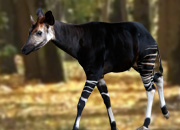
Okapi
Okapi is a unique creature which resembles a zebra, a horse, a giraffe, a deer and a mule at the same time. It is an organism which possesses distinctive black and white stripes of a zebra on certain parts of its body. Its head, tongue and horns give it the appearance of a giraffe. Its ears resemble that of a mule when seen from a side while from the front, it looks like it has the ears of a moose. In reality, the creature is biologically related to giraffes, but quite distantly.
As there are a limited number of okapis in the world, most people would have never seen or heard of this bedazzling creature before. Ironically, its history dates back to the time of the ancient Egypt, using old carvings as the proof of its existence. Moreover, African myths related to a legendary African Unicorn before the onset of the twentieth century also suggest the existence of this unique organism. Today, less than ten thousand okapis are found in parts of Congo and Sudan. Their predators—leopards—as well as poachers are causing their surviving members to diminish every year.
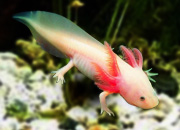
Mexican Walking Fish
Have you ever seen a fish with feet which is one of the rare animals in the world? There is a species of salamander found in the waters of Mexico which looks like a fish with cute little limbs. This creature exists in a number of beautiful colors, making it even more interesting. Some of them, called harlequin or piebald, have multi colored bodies.
Scientists have discovered that the numbers of the Mexican Walking fish have been greatly reduced from fifteen hundred per square mile to less than twenty-five. This drastic decrease has put these unique creatures in the list of endangered species. The main reason behind this unfortunate endangerment is the destruction of natural habitat. These amphibians also eat their fellows as well the eggs of other Mexican Walking fish. This can be counted as a reason why these creatures do not thrive in large numbers. Therefore, keeping them in captivity would also be a problem as the owner would have to keep them in solitude.
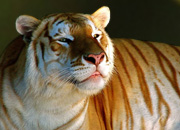
Strawberry Tiger
More popularly known as the Golden Tabby Tiger, these formidable creatures are one of the most beautiful cats. A white coat with blond and golden patches distinguishes it from other tigers of the world. The reason behind this variation in color is a recessive gene. Although scientists have discovered that this gene is carried by many tigers, it is expressed as a physical trait in only a few of them.
A strawberry tiger is, therefore, not a separate species. These beautiful creatures are born by chance through parents who simply carry the gene. Today, only thirty of these rare animals are found in the world. Breeders can only produce them by chance as the carriers of the responsible gene are impossible to isolate.
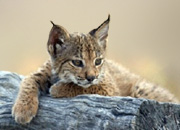
Iberian Lynx
Iberian lynx is another unique cat which is, unfortunately, on the verge of extinction. Only thirty-six of these adorable creatures remain in the world found only in Andalusia. You can see them only in rare animals pictures now. The lynx is only 85-110 cm in length whereas its spotted coat resembles that of a leopard. The destruction of the natural habitat and the subsequent reduction in the number of their prey are the main reasons why there is such a small number of Iberian lynx remaining on the planet Earth. The lynx cannot adapt by changing its dietary habits. Therefore, its dependence on its particular prey has deprived the entire population of food. Moreover, some of these innocent cats have also been killed by rabbit traps.

Yangtze River Dolphin
Also known as Baiji, this friendly freshwater creature is confined to the Yangtze River of China. As the country became more industrialized, the use of this river for transportation increased and the population of dolphin started diminishing. Moreover, the production of hydroelectricity resulted in reducing the number of Baiji. Sadly, only thirteen of these lovely creatures can now be found swimming around in the river. The Yangtze River Dolphin is also known as the White Flag Dolphin or the Whitefin Dolphin. It looks just like the other species of dolphins. However, an interesting trait possessed by the baiji is its ability to see. Its sight is, nevertheless, as poor as the sight of a hundred years old man.
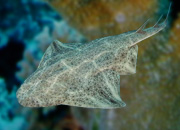
Angel Shark
Angel is a word which can hardly ever be used to describe a blood-thirsty shark. However, not all species of this formidable water creature are scary. Angel shark, a member of the genus Squatina is one of them. Its broad pectoral fins look like the wings of an angel, hence the name angle shark. These large fins also give it the appearance of a ray fish. The natural habitat of these unique sharks is found in the Mediterranean Sea, the Northeast Atlantic Ocean and the Black Sea. However, overfishing has caused its populations to diminish. Today, the fish can only be located in parts of the Southern Mediterranean Sea. Apart from its limited number, another reason why the Angel shark is so hard to find is due to its excellent camouflaging abilities. The flat fish can camouflage itself with the ocean sand while it waits for the prey. The creature is then hard to distinguish from the sea bed. These unique creatures might completely vanish from the Earth in the near future. It is unfortunate how the world is losing some of the most magical organisms which once roamed around in abundance.
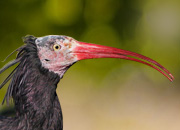
Northern Bald Ibis
With the long red and beautifully curved bill, the huge flying creature is facing the extreme danger of extinction in the near future. Scientifically known as Geronticus eremita, the beautiful migratory bird belongs to the family Threskiornithidae, which consists of 34 species of large wading birds. The glossy black ibis has a thick coat of feathers on its body but the red face is bare without any hair on it. Once a huge population of the creature spread throughout the European and the Middle Eastern countries, but now, according to a survey conducted in 2002, fewer than 600 individuals are said to be surviving in Syria and southern parts of Morocco. In the European continent, its population became extinct millions of years ago and only the fossil records are found that are 1.8 million years old. The barren and rocky places with running water constitute the favorite habitation for this semi desert bird. Unlike other members of its family, Northern bald ibis has been found to be a non-wader as it avoids water, but lives near to it. In the breeding season, it migrates to the mountainous and coastal areas where it lays 2 to 3 eggs in the nests built of sticks. Various small animals like insects and lizards constitute its favorite diet which it can easily catch and kill with its very long curved bill. However, while going for feeding, they fly from the breeding places to the feeding areas in the form of large flocks. World’s major wildlife conservation authorities have been alarmed with its rapidly dwindling population and making serious efforts for the facilitation of the natural habitat. In this context, the species is being reintroduced in Austria, Spain, Turkey and northern parts of Morocco.
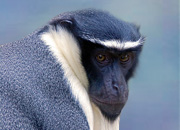
Roloway Monkey
Do you know what the Old World Monkeys are and where they are found today? These animals belong to the superfamily Cercopithecoidea the member species of which are found to inhabit the continents of Africa and Asia. Scientifically known as Cercopithecus roloway, this primate is facing the imminent danger of extinction as the International Union for Conservation of Nature (IUCN) has already placed it in the red list of endangered animals. Once widespread across many regions of the world, the population of Roloway monkey is found limited to only certain regions of Ghana and Cote d’Ivoire, particularly, between the Pra and Sassandra rivers. Though the species of genus Cercopithecus are more commonly known as ‘guenons’, this particular monkey is an exception to it because of having lengthy beard which is absent in the other members. The feather coat represents a beautiful combination of three contrastive colors, viz. black, orange and white. The back and hips are colored orange, the interior of arms and neck region are white, while the remainder of the body is shiny black. The favorite diet of the monkey consists of various insect species, flowers, fruits and seeds. Being arboreal animals, they live and find their diet in trees, but they do not have a solitary type of lifestyle and move in the form of the social groups of up to 30 individuals. Concerning the weight and body dimensions of this charming creature, it measures up to 55 cm in length with the maximum body mass of 7 kg. It is very unfortunate to know that in the period of their last three generations; more than 80% of their population has declined. That is why serious and large scale efforts are on the way, by the international community, for the protection of the surviving individuals and their reintroduction in other parts of the world.
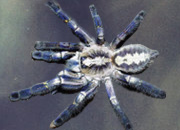
Gooty Tarantula
Known with a number of other attractive common names, such as ‘peacock parachute spider’ and ‘Gooty saphire’, this brightly colored natural beauty of the planet earth is at the extreme verge of extinction, probably, in the near future. The most surprising thing about this rare species of animals is that its body reflects brilliant metallic blue color that at once appeals to your eyes. This very feature is partly represented by its scientific name as well, i.e. Poecilotheria metallica. The fractal-like pattern, a characteristic feature of all the species of this genus, serves as a source of further fascination. The entire population of metallic tarantula is limited to only a small reserve forest area (measuring about 100 km) in India. This already much localized natural habitat is going through many human-induced disturbances.
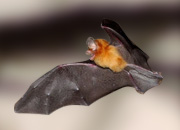
Cuban Greater Funnel-Eared Bat
One of the two surviving species of the genus Chilonatalus, its natural habitat extends across some Caribbean and other nearby countries, including Cuba, Haiti, Columbia, and Dominican Republic. One of the most prominent characteristic features of these flying mammals (as obvious in their common name) is that of their large funnel shaped ears with glandular papillae on their external parts. The ‘natalid organ’ is a special structure located on the muzzle of the adult males. Found only in the family Natalidae, the structure is made up of sensory cells but, surprisingly, it is involved only in certain glandular functions. Usually found in caves, the largest Caribbean representative of the small ancient family is facing the threat of endangerment, and if not protected timely, it will soon go extinct.
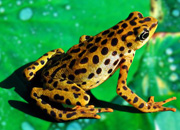
Rio Pescado Stubfood Toad
Native to the geographical region of Ecuador, it is one of the species of toads that is scientifically known a Atelopus balios. The most favored places include the moist lowland forests and rivers in the tropical and subtropical regions.
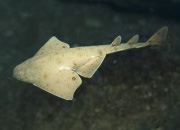
Japanese Angel Shark
As the very name suggests, Squatina japonica (scientific name), it naturally dwells in the northwestern Pacific Ocean, especially, in and around the Japanese Archipelago.
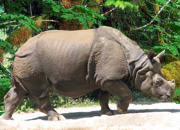
Java Rhino
One of the five surviving species of rhinos, it is scientifically termed as Rhinoceros sondaicus, and is adopting Java island of Indonesia as its natural habitat. With only 100 individuals, this beauty of the planet earth is classified as critically endangered which may soon go into extinction.
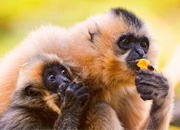
Hainan Black Crested Gibbon
Scientifically termed as Nomascus hainanus, the entire population of this critically endangered animal is limited to the Hainan Island of china.
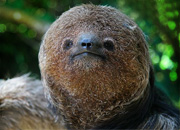
Pygmy Three-Toed Sloth
Also known as dwarf sloth or monk sloth, it is under the critical threat of endangerment. Scientifically known as Bradypus pygmaeus, it is endemic to an island off the coast of Panama.
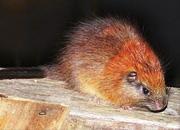
Red Crested Tree Rat
Endemic to Columbia, this critically endangered species of a very beautiful rat is scientifically termed as Santamartamys rufodorsalis. The most favored living conditions for this animal are that of humid montane (mountainous) forests.
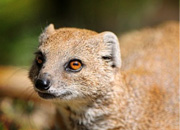
Durrell's Vontsira
Native to the island country of Madagascar, it is one of the rarest mammalian species on earth and is scientifically known as Salanoia durrelli. This small reddish-brown animal has broad feet and is a carnivore in its feeding style.
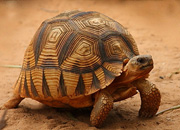
Ploughshare Tortoise
Alternatively known as “Madagascar Angulated Tortoise”, it is one of the critically endangered species of tortoises that has got a beautiful body texture. In scientific terminology, it is named as Astrochelys yniphora where the former is the name of its genus while the latter denotes species.
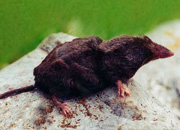
Nelsons Small-Eared Shrew
As the very name indicates, it was discovered by Edward William Nelson in the last quarter of the 19th century. Native to the eastern part of Mexico, this mammalian species has been classified among the critically endangered species on earth.
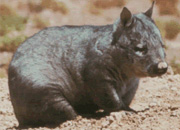
Northern Hairy-Nosed Wombat
One of the three surviving species of wombats, the mammal is already under the great threat of extinction. Restricted to a small area in Queensland (about 3-km2), the entire population consists of just 113 individuals.
Latest Fish
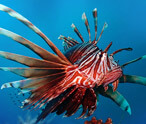
Lionfish Facts
Lionfish is a chordate which belongs to the family...read more
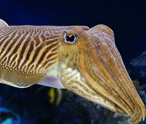
Cuttlefish Facts
Cuttlefish is a mollusk which belongs to the class...read more

Octopus Facts
Do you know how, in the floor of an ocean, an octopus...read more

Sea Urchin Facts
Sea urchins are tiny water creatures found in oceans...read more
Latest Birds
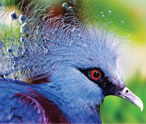
Victoria Crowned Pigeon
With its name...read more
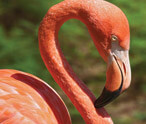
Information About Flamingos
Flamingos are...read more
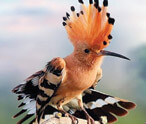
Hoopoe Bird
Famous for its distinctive crown of...read more
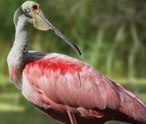
Roseate Spoonbill
The beautiful Roseate Spoonbill...read more


















Largest Birds of Prey in the World by Size and Weight
Also called raptors, the birds...
List of Birds That Fly in V Formation
Did you ever feast your eyes on the amazing phenomenon...
Birds of Prey List
A bird of prey is also known as a raptor or a hunter. It belongs to the group of...
Millipedes Vs Centipedes
Centipedes and millipedes are both arthropods from the group...
Difference Between Warm Blooded and Cold Blooded Animals
Every living organism...
Top 10 Extremely Dangerous Insects
The insects have been grouped in class 'insecta' of...
Sheep Vs Goat
The goat and the sheep are related to each other through the same family. They...
Animals with Blue-colored Blood
Humans and other vertebrates have red-colored blood running...
Birds, Mammals And Reptiles
Before coming to the question of common ancestry of birds...